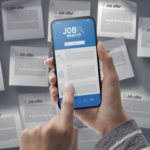As HG Wells might have penned it: “No one would have believed in the early years of the twentyfirst century that a new world of work would emerge from a pandemic, like some paradisiacal hinterland. With infinite complacency, organisations went to-and-fro about their affairs, serene in the assurance that hybrid was an eternal panacea. Yet across the gulf of work, minds vast and cool and unsympathetic, regarded it with anxious eyes and slowly and surely drew up their HR plans.”
Employer branding has become progressively more important, as employees have positively embraced the realisation that they hold in their hands the very life blood of their organisations. But CEOs are feeling overwhelmed at the challenge to reshape their employer brand as they feel powerless to control or even exert influence over social media. With sites offering very public platforms for disgruntled employees, many organisations don’t know where to begin. Forbes magazine recently noted that, “in this day and age, social media can make or break an organisation’s reputation.” As employees realise their powerbase and seize the opportunity for employee activism, it is heartening to see that HR is reestablishing the importance of managing organisational reputation. But leadership at all levels needs to take ownership of the perception of what it is like to work at their company and accept that it is the entirety of the employment experience and so having a strategy to set, manage and develop it is essential to create a reputation that attracts and keeps top talent. The term “employer branding” has been around for a long time and had its original heyday in the early 1990’s when there was an abundance of job opportunities and employers had their first real experience of worker power. Simon Barrow, the founder of People in Business, is credited with first coining the phrase, defining it as “the package of functional, economic and psychological benefits provided by employment and identified with the employing company”. Although I prefer Will Ruch’s definition when he said a few years later and I paraphrase here that, “employer branding is an organisation’s image, as seen through the eyes of its employees and potential employees.”
The future of employer branding and the role HR will play in delivering it will be quite different going forward. From its inception, employer branding focused almost entirely on delivering an organisation’s aim to be an employer of choice. However, that will change very quickly in today’s increasingly complex business environment. With diverse labour markets all enjoying a global social media explosion, the concept of employer branding carries an even greater resonance. HR must see beyond employer branding simply delivering an appealing image and seek out a new a wider provision that will meet people’s rising aspirations towards the psychological as well as the financial rewards of their work. From my ITU (Ivory Tower of Unaccountability) – sometimes known as retirement – I proffer to suggest four new and exciting aspects of employer branding, that I believe will develop and overtake any previous understandings of this area of HR strategic influence. In my opinion these new strands to employer branding will grow and become incredibly powerful tools to ensure the future relationship between the employer and employee continues to grow exponentially to create a new and as yet unseen partnership. Finally, after years of crying in the wilderness, employers – and especially finance directors – will finally be convinced by the incessant tub-thumping of HR, which for decades has fought to convince organisations of the value of investing beyond the basic cost of resourcing into a whole new area of employee experience, from onboarding to retention.
Firstly, I believe the future will see employees as the single most important branding tool of every organisation. The empirical evidence speaks for itself, for years we have known that candidates trust an organisation’s employees three times more than the company itself, yet we have done little more than play lip service to this knowledge offering staff contact as only a minimal part of any recruitment process. When it comes to providing credible information about what it’s like to work in an organisation the best place to go is the canteen not the boardroom. Take note, the employees which are already in your organisation will have, on average, ten times more LinkedIn connections than their company has followers. Secondly, it will come as no surprise that social media’s role in employer branding will grow aggressively as we go forward. We have seen this in so many ways recently where traditional news channels are usurped and major influencers, like the CBI, are shaken to their core as social media becomes the most important digital influencer. All indications are that the use of social media will continue to increase in usage and influence in future. I have read that some analysts are predicting that up to 80 percent of current jobseekers are likely to use social media in their job search. Furthermore, I believe that any organisations that are already harnessing a strong social media strategy will have seen the “double whammy” of also re-engaging their current workforce. Going forward, HR will need to become the experts in this area and not only benefit from social media, but actually be able to harness and measure the costs and benefits of social media engagement.
I believe a third aspect of this new HR approach to employer branding will see the Employee Value Proposition come alongside the employer branding proposition working in parallel to ensure the value employees have from working at a company goes well beyond the actual financial reward. Indeed, the EVP must blend with the branding to develop a holistic experience that quantifies the real value and impact employees have from working in an organisation. Currently it is estimated that less than two-thirds of organisations have a credible EVP in place and even where they have them, they are considered separate and delivering against two separate objectives. Going forward this needs to change, it’s becoming clear that in the future of employer branding, success is unlikely unless there is a parallel EVP in place. Finally and most significantly I believe in future we will see greater blending in HR strategic planning around employer branding and consumer branding which I believe will come together to form a new and vastly different engagement process within organisations. Social media, education and generational expectations are all weaving a new set of thought processes, which will create a new and quite different job seeker, using a myriad of sources and data to learn about an organisation even if they choose ultimately not to take a role. Modern job seekers are latter day sherlock Holmes. They research companies in significant detail before even considering applying for a role. These jobseekers-come-detectives will spend up to three hours researching a potential future organisation, during which time, they will not only have perused the organisation’s website, but they will also have trawled through a host of other sites including LinkedIn, Glassdoor and Facebook in search of clues to what an organisation is really like, what its values are and as to whether the organisation is living up to those values. These employment detectives will be ingesting all of the branding – especially the information that was not originally developed as a recruitment tool – and they will be looking at how organisations position themselves as employers. They will even be carefully dissecting clues that show off an organisation’s heart. The importance of brand cannot be underestimated. Customer-facing or employer brand, it is as emotive, partisan and representative as a flag and can attract and bind or repel and diffuse. History shows us that above all, brand is complex.
FOR FURTHER INFO WWW.LINKEDIN.COM/IN/GRAHAM-WHITE-508230A
Read the latest issue and more enlightening articles for free by clicking HERE.
Or you can subscribe to our publication monthly in PRINT & DIGITAL.
When you subscribe you will also be helping SANDS, saving babies’ lives. Supporting bereaved families.









